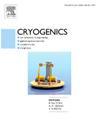Development of a 187 K free-piston Stirling cryocooler with wound wire mesh regenerator
IF 2.1
3区 工程技术
Q3 PHYSICS, APPLIED
引用次数: 0
Abstract
Stirling cryocoolers are widely used in low-temperature storage because the advantages such as high reliability and efficiency. To meet the demands of commercialization, the production process of Stirling cryocoolers needs to reduce costs. Compared to stacked wire mesh regenerator, wound wire mesh regenerator has emerged as a new option to reduce the cost of regenerators, as it eliminates the need for manual filling of regenerator matrix and consumes less metal. In this manuscript, an investigation is conducted focusing on the characteristics of this wound wire mesh regenerator. To cool the −86℃ ultra-low temperature refrigerators, a free-piston Stirling cryocooler with a wound wire mesh regenerator was developed, and one-dimensional simulation and experiments were conducted on the cryocooler. To better optimize cryocooler design, theoretical research was conducted on refrigeration losses of cryocooler. Analysis and simulation of the theoretical and actual energy flow distribution in the cryocooler were conducted. The proportion of internal losses for different components was analyzed. Simulations were performed to investigate the impact of on internal losses within the regenerator and the refrigeration efficiency of the cryocooler, working parameters and cold end temperature. The simulation results were experimentally validated, and the performance of the cryocooler was tested in terms of cooling characteristics and operational stability. The prototype of the optimized cryocooler design achieved a cooling capacity of 120 W@187 K, with a minimum attainable cold end temperature of 121.1 K.
187k带绕丝网蓄热器的自由活塞斯特林制冷机的研制
斯特林制冷机因其可靠性高、效率高等优点,在低温储存中得到了广泛的应用。为了满足商业化的需求,斯特林制冷机的生产过程需要降低成本。与堆叠式钢丝网蓄热器相比,缠绕式钢丝网蓄热器已经成为降低蓄热器成本的一种新选择,因为它消除了人工填充蓄热器基质的需要,并且消耗的金属更少。在这篇手稿中,对这种缠绕钢丝网再生器的特性进行了调查。为了冷却−86℃超低温制冷机,研制了一种带绕线网蓄热器的自由活塞斯特林制冷机,并对该制冷机进行了一维仿真和实验研究。为了更好地优化制冷机的设计,对制冷机的制冷损失进行了理论研究。对制冷机内的理论和实际能量流分布进行了分析和仿真。分析了不同组分内部损耗的比例。通过数值模拟研究了不同温度对蓄热器内部损耗、制冷机制冷效率、工作参数和冷端温度的影响。对仿真结果进行了实验验证,并对制冷机的制冷特性和运行稳定性进行了测试。优化设计的制冷机原型制冷量为120 W@187 K,最低冷端温度为121.1 K。
本文章由计算机程序翻译,如有差异,请以英文原文为准。
求助全文
约1分钟内获得全文
求助全文
来源期刊

Cryogenics
物理-热力学
CiteScore
3.80
自引率
9.50%
发文量
0
审稿时长
2.1 months
期刊介绍:
Cryogenics is the world''s leading journal focusing on all aspects of cryoengineering and cryogenics. Papers published in Cryogenics cover a wide variety of subjects in low temperature engineering and research. Among the areas covered are:
- Applications of superconductivity: magnets, electronics, devices
- Superconductors and their properties
- Properties of materials: metals, alloys, composites, polymers, insulations
- New applications of cryogenic technology to processes, devices, machinery
- Refrigeration and liquefaction technology
- Thermodynamics
- Fluid properties and fluid mechanics
- Heat transfer
- Thermometry and measurement science
- Cryogenics in medicine
- Cryoelectronics
 求助内容:
求助内容: 应助结果提醒方式:
应助结果提醒方式:


